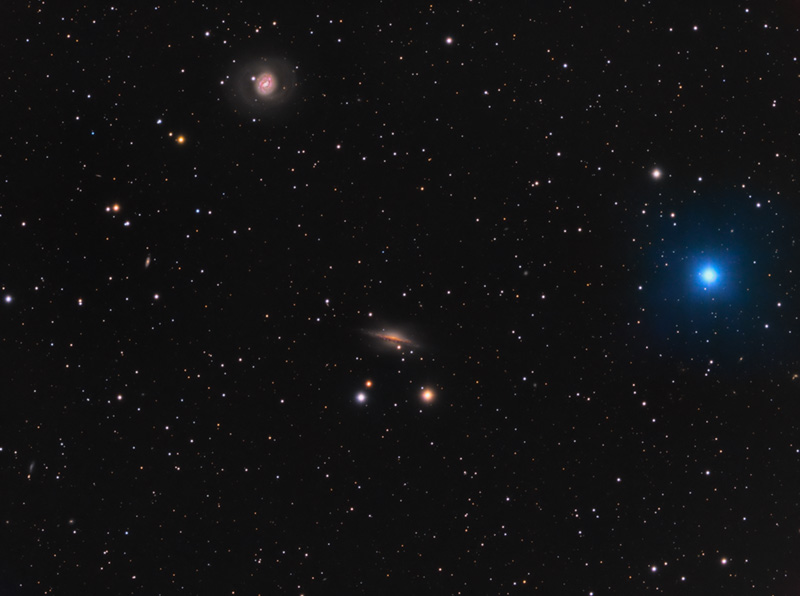
M77 is an SB barred spiral galaxy and is about 47 million light-years distant in the Cetus. M77 has a diameter that is estimated at 170,000 light-years.
M77 was discovered by Pierre Méchain in 1780, who originally described it as a nebula. Méchain then communicated his discovery to Charles Messier, who subsequently listed the object in his famed catalog. Both Messier and William Herschel described this galaxy as a star cluster, although Herschel’s description of it changed as he observed it with larger telescopes. After seeing it in his 6”, 7-foot focal length telescope in 1783, he described M77 as an “ill defined star, surrounded by nebulosity.” Between 1801 and 1810, he observed it in his 9”, 10-foot focal length telescope and noted that it had “almost the appearance of a large stellar nebula.” He later observed the galaxy in his large 18”, 30-foot focal length telescope and remarked, “A kind of much magnified stellar cluster; it contains some bright stars in the centre. With 171 its diameter is 1′ 17″; with 220 it is 1′ 36″.”
Admiral William Henry Smyth observed M77 in October 1836 and described the galaxy with the following description: “A round stellar nebula, near Delta in the Whales’s lower jaw, and about 2 1/2 deg from Gamma on the line towards Epsilon, or s. by w. This was first classed by M. [Messier] in 1780 as a mass of stars containing nebulosity. It is small, bright, and exactly in a line with three small stars, one preceding and two following, of which the nearest and largest is a 9th-magnitude to the sf [south following, SE]. There are other minute companions in the field; and the place is differentiated from Gamma Ceti.This object is wonderfully distant and insulated, with presumptive evidence of intrinsic density in its aggregation; and bearing indication of the existence of a central force, residing either in a central body or in the centre of gravity of the whole system. Sir William Herschel, after repeatedly examining it, says, – “From the observations of the large ten-feet telescope, which has a gauging power of 75.82, we may conclude that the profundity of the nearest part is at least of the 910th order.” That is, the 910 times as far off as the stars of the first magnitude!”
Today, however, the object is known to be a galaxy.
M77 is an active galaxy. It is classified as a type 2 Seyfert galaxy and is the brightest galaxy of this type in the sky. Named after the American astronomer Carl Seyfert, who was the first to identify the class in 1943, Seyfert galaxies are characterized by hot, highly ionized gas around an extremely active centre. M77 serves as the prototype for the class. The galaxy’ active galactic nucleus (AGN) is hidden from view by dust and cannot be seen in visible light.
From 1940 to 1942 as a National Research Council Fellow at Mt. Wilson Observatory, Carl Seyfert did pioneering research, while at Mt. Wilson Observatory, of nuclear emission in spiral galaxies: In 1943, he published a paper on galaxies with bright nuclei that emit light with emission line spectrum, and exhibit characteristically broadened emission lines. These galaxies are since called Seyfert Galaxies; the most prominent example, identified as such by Seyfert, is M77. Since, the class of Seyfert galaxies has been shown to be a subclass of a much wider group, the galaxies with Active Galactic Nuclei (AGNs).
M77 is also the nearest Seyfert galaxy to the solar system, and one of the most studied galaxies in the sky. Classified as a barred spiral, M77 has loosely wound spiral arms, dotted with countless star forming regions, and a small central bulge. The supermassive black hole at the galaxy’s core has an estimated mass of around 15 million times that of the Sun and is less than 12 light years in diameter. The galaxy itself has a mass of about 1 billion solar masses.
The galaxy’s spectrum shows broad emission lines, indicating that large gas clouds are rapidly moving out of the galaxy’s central region at velocities of several 100 km/s. The energy source responsible for the high velocities is found in the nucleus of M77, which is a strong source of radio emissions. The source is known as Cetus A and 3C 71.
NGC 1055 is an Sb edge-on spiral galaxy also in Cetus, and displays a prominent central bulge with a distinct lumpy dark lane of dust and gas. NGC 1055 was discovered by William Herschel on December 19, 1783.
M77, NGC 1055, NGC 1073,and five other small irregular galaxies form a gravitationally linked galaxy group. M77 and NGC 1055 are the largest galaxies of this small galaxy group.
NGC 1055 is 52 million light-years distant, with a diameter of about 115,800 light-years. The separation between NGC 1055 and M77 is about 442,000 light-years.
M77 and NGC 1055 can be seen through an 8” SCT or 8” Newtonian using a moderate low magnification and wide field eyepiece with a field-of-view of 68°or more. M77 is an easy target in dark country skies. Dark skies and dark adapted eyes are necessary to spot NGC 1055. I have sighted this Cosmic Duet through my 130 mm apochromat refractor (the benefits of great optics and high contrast) in the dark Virginia country skies of my backyard..